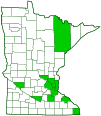Common eastern physocephala
(Physocephala tibialis)
Conservation • Description • Habitat • Ecology • Distribution • Taxonomy
Conservation Status |
|||
| IUCN Red List | not listed |
||
| NatureServe | not listed NNR - Unranked |
||
| Minnesota | not listed |
||
Description
Common eastern physocephala is a medium-sized thick-headed fly. It is common in the United States from the east coast to the Midwest but mostly east of the Mississippi River. It is less common in Minnesota where it is at the western edge of its range.
At 7 ⁄16″ to ½″ long, it is a medium-sized fly but is relatively large for the genus Physocephala. With its thread-waisted body it strongly resembles a wasp, and like a wasp, it parasitizes living insects.
The head is bulbous and large, a little wider than the thorax. The top of the head (vertex) is dark brown or black. There is a narrow white line on the back of the head (occiput). There are two large compound eyes and no simple eyes (ocelli). The compound eyes are situated at the sides of the head and do not meet in the middle on either sex. The face is mostly white and prominently grooved. There is a black, fairly wide, sharply defined, T-shaped mark on the upper face (frons). The cheeks and facial grooves are black, and the facial keel is black, at least at the top. There is a very narrow silvery stripe on the face along the margin of the compound eye. The protruding mouthpart (proboscis) projects forward needle-like. It is long, straight (not elbowed), black, and conspicuously swollen at the base. The antennae have three segments. They are straight, black, and long, longer than the head, and project forward and up. The first segment is about the same length as the third. The second segment is as long as the first and third combined. The third segment is cone-shaped and has a slender, elongated process (style) at the tip.
The thorax is black and appears dusted whitish when viewed at an angle. The front angles (humeral spots) are narrow, black, and raised like shoulder pads. The balancing organs (halteres) are knob-like and yellow. The exoskeletal plate between the thorax and abdomen (scutellum) is dark brown or black.
The abdomen is black with a narrow band at the end (posterior) of each segment. The band is wider and white on segments one and two, narrower and yellowish-white on the remaining segments. The second segment and part of the third are very constricted (petiolate). Segments four through six have a white dusting above.
The legs are mostly black. The second segment (trochanter) and the base and tip of the third segment (femur) are yellowish-red. The femurs on the hind leg is irregularly thickened and is widest near the base. The fourth segment (tibia) is white on the basal half, reddish-brown on the outer (distal) half. The last part of the leg (tarsus), corresponding to a foot, has five segments. On the front and middle legs they are reddish at the base and black at the end. On the hind legs they are all black.
The forward (anterior) half of each wing is dark, the remaining is clear. The cell at the leading edge (costal cell) is usually the same dark color as adjacent cells, but is sometimes lighter or even clear. The discal cell is entirely dark and strongly indented at the first (anterior) cross-vein, which is is located well beyond the middle of the cell.
Size
Total length: 7 ⁄16″ to ½″
Similar Species
Habitat
Ecology
Season
June and July
Behavior
Adults are active during the day and are usually found on flowers.
Life Cycle
The female grasps a bumble bee in flight and forces an egg between the bee’s abdominal segments.
Larva Food/Hosts
Two-spotted bumble bee, brown-belted bumble bee, and common eastern bumble bee
Adult Food
Distribution |
||
|
Sources |
|
| 9/30/2025 | ||
Occurrence |
||
|
||
Taxonomy
Order
Suborder
Brachycera
Infraorder
Cyclorrhapha
Zoosection
Schizophora
Zoosubsection
Acalyptratae (acalyptrate flies)
Superfamily
Conopoidea (kelp, marsh, thick-headed flies, and allies)
Family
Conopidae (thick-headed flies)
Subfamily
Conopinae
Tribe
Physocephalini
Genus
Physocephala
Subordinate Taxa
Synonyms
Conops fulvipennis
Conops lugubris
Conops nigricornis
Conops tibialis
Common Names
common eastern physocephala
Glossary
Costa
On plants: The central axis of a pinna, to which pinnules are attached. On insects: The vein on the leading edge of the forewing.
Femur
On insects and arachnids, the third, largest, most robust segment of the leg, coming immediately before the tibia. On humans, the thigh bone.
Frons
The upper front part of an insect’s face, roughly corresponding to the forehead.
Halteres
In flies: a pair of knob-like structures on the thorax representing hind wings that are used for balance.
Occiput
The back of the head. In Odonata, Megaloptera, and Neuroptera, the upper part of the head behind the eyes.
Ocellus
Simple eye; an eye with a single lens. Plural: ocelli.
Proboscis
The protruding, tubular mouthpart of a sucking insect.
Scutellum
The exoskeletal plate covering the rearward (posterior) part of the middle segment of the thorax in some insects. In Coleoptera, Hemiptera, and Homoptera, the dorsal, often triangular plate behind the pronotum and between the bases of the front wings. In Diptera, the exoskeletal plate between the abdomen and the thorax.
Tibia
The fourth segment of an insect leg, after the femur and before the tarsus (foot). The fifth segment of a spider leg or palp. Plural: tibiae.
vertex
The upper surface of an insect’s head.
Visitor Photos
Share your photo of this insect.
This button not working for you?
Simply email us at info@MinnesotaSeasons.com.
Attach one or more photos and, if you like, a caption.
Alfredo Colon |
||
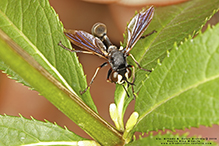 |
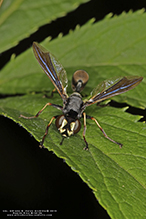 |
|
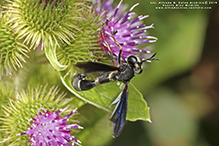 |
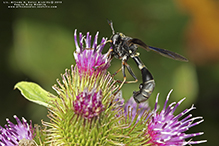 |
|
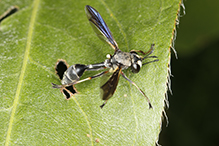 |
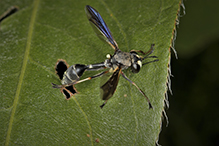 |
|
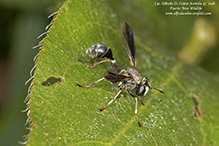 |
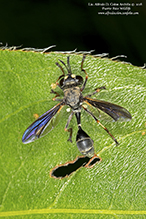 |
|
MinnesotaSeasons.com Photos
|

Slideshows

Visitor Videos
Share your video of this insect.
This button not working for you?
Simply email us at info@MinnesotaSeasons.com.
Attach a video, a YouTube link, or a cloud storage link.
Other Videos
A Parasitoid Fly that is a Wasp Mimic (Physocephala tibialis)
Nature in Motion

Visitor Sightings
Report a sighting of this insect.
This button not working for you?
Simply email us at info@MinnesotaSeasons.com.
Be sure to include a location.
MinnesotaSeasons.com Sightings

